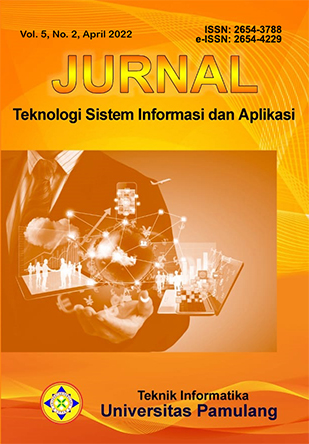Pengujian Aplikasi Sistem Informasi Absensi Karyawan PT Prakarsa Mitra Andalan Menggunakan Metode Black Box
Kata Kunci:
software, blackbox method, equivalence partitioning techniqueAbstrak
Technological developments that gave birth to many quality software products. Quality software is software that has gone through testing. In software testing there are several things that must be tested, namely the software must be in accordance with what the user wants or needs, the software must work well when used so that there are no errors, the software must have a good response time when run. Software must be a cost and time efficiency solution. In software testing, one of the methods used is by using the blackbox method. The blackbox method has its own technique, one of which is the equivalence partitioning technique. The equivalence partitioning technique is a technique of dividing several parts or partitions to check each part or partition by testing the software.
Referensi
Andriansyah, D. (2018). Pengujian Kotak Hitam Boundary Value Analysis Pada Sistem Informasi Manajemen Konseling Tugas Akhir. IJNS - Indonesian Journal on Networking and Security, 7(1), 13-18. doi:10.2311/ijns.v7i1.1496
Aziz, I. A., Setiawan, B., Khanh, R., Nurdiyansyah, G., & Yulianti, Y. (2020). Pengujian Black Box pada Aplikasi Sistem Kasir Berbasis Website Menggunakan Teknik Equivalence Partitions. Jurnal Teknologi Sistem Informasi dan Aplikasi, 3(2), 10.32493/jtsi.v3i2.4693. doi:10.32493/jtsi.v3i2.4693
Hendri, H., Manurung, J. W., Ferian, R. A., Hanaatmoko, W. F., & Yulianti, Y. (2020). Pengujian Black Box pada Aplikasi Sistem Informasi Pengelolaan Masjid Menggunakan Teknik Equivalence Partitions. Jurnal Teknologi Sistem Informasi dan Aplikasi, 3(2), 107-113. doi:10.32493/jtsi.v3i2.4694
Maulana, A., Kurniawan, A., Keumala, W., Sukma, V. R., & Saifudin, A. (2020). Pengujian Black Box pada Aplikasi Penjualan Berbasis Web Menggunakan Metode Equivalents Partitions (Studi Kasus: PT Arap Store). Jurnal Teknologi Sistem Informasi dan Aplikasi, 3(1), 50-56. doi:10.32493/jtsi.v3i1.4307
MZ, M. K. (2016). Pengujian Perangkat Lunak Metode Black-Box Berbasis Equivalence Partitions pada Aplikasi Sistem Informasi Sekolah. Jurnal Mikrotik, 2-8.
Ningrum, F. C., Suherman, D., Aryanti, S., Prasetya, H. A., & Saifudin, A. (2019). Pengujian Black Box pada Aplikasi Sistem Seleksi Sales Terbaik Menggunakan Teknik Equivalence Partitions. Jurnal Informatika Universitas Pamulang, 4(4), 125-130.
Nugraha, B. F., Aditama, F., Arrofi, M., Ahmad, S. U., & Yulianti, Y. (2020). Pengujian Black Box pada Aplikasi Penghitungan Parkir Swalayan ADA Menggunakan Teknik Equivalence Partitions. Jurnal Informatika Universitas Pamulang, 5(2), 146-151. doi:10.32493/informatika.v5i2.5350
Pratala, C. T., Asyer, E. M., Prayudi, I., & Saifudin, A. (2020). Pengujian White Box pada Aplikasi Cash Flow Berbasis Android Menggunakan Teknik Basis Path. Jurnal Informatika Universitas Pamulang, 5(2), 111-119. doi:10.32493/informatika.v5i2.4713
Pratama, B. P., Ristianto, I. B., Prayogo, I. A., Nasrullah, & Saifudin, A. (2020). Pengujian Perangkat Lunak Sistem Informasi Penilaian Mahasiswa dengan Teknik Boundary Value Analysis Menggunakan Metode Black Box Testing. Journal Of Artificial Intelligence And Innovative Applications, 32-36.
Sartika, D., Andreswari, D., & Anggriani, K. (2016). Sistem Pendukung Keputusan Penentuan Posisi Ideal Pemain dalam Cabang Olahraga Sepak Bola dengan Menggunakan Pendekatan Dua Metode Naive Bayes dan Profile Matching. Rekursif, 4(3), 311-324. doi:10.33369/rekursif.v4i3.1000
Shaleh, I. A., Prayogi, J., Pirdaus, P., Syawal, R., & Saifudin, A. (2021). Pengujian Black Box pada Sistem Informasi Penjualan Buku Berbasis Web dengan Teknik Equivalent Partitions. Jurnal Teknologi Sistem Informasi dan Aplikasi, 4(1), 38-45. doi:10.32493/jtsi.v4i1.8960
Sinulingga, A. R., Zuhri, M., Mukti, R. B., Syifa, Z., & Saifudin, A. (2020). Pengujian Black Box pada Sistem Aplikasi Informasi Data Kinerja Menggunakan Teknik Equivalence Partitions. Jurnal Teknologi Sistem Informasi dan Aplikasi, 3(1), 9-14. doi:10.32493/jtsi.v3i1.4303
Taufiq, R., Magfiroh, D. A., Yusup, D., & Yulianti, Y. (2020). Analisis dan Desain Sistem Informasi Pembayaran Sumbangan Pembinaan Pendidikan (SPP) di SMK Avicena Rajeg. Jurnal Teknologi Sistem Informasi dan Aplikasi, 3(1), 15-21. doi:10.32493/jtsi.v3i1.4308
Unduhan
Diterbitkan
Cara Mengutip
Terbitan
Bagian
Lisensi
Hak Cipta (c) 2022 Sri Mulyati, Irpan Kusyadi, Sulthon Aulia Azis Akbar, Alex Saputra, Henriansyah Hidayat

Artikel ini berlisensi Creative Commons Attribution-NonCommercial 4.0 International License.
Authors who publish with this journal agree to the following terms:
- Authors retain copyright and grant the journal right of first publication with the work simultaneously licensed under a Creative Commons Attribution License that allows others to share the work with an acknowledgement of the work's authorship and initial publication in this journal.
- Authors are able to enter into separate, additional contractual arrangements for the non-exclusive distribution of the journal's published version of the work (e.g., post it to an institutional repository or publish it in a book), with an acknowledgement of its initial publication in this journal.
- Authors are permitted and encouraged to post their work online (e.g., in institutional repositories or on their website) prior to and during the submission process, as it can lead to productive exchanges, as well as earlier and greater citation of published work (See The Effect of Open Access).
Jurnal Teknologi Sistem Informasi dan Aplikasi have CC BY-NC or an equivalent license as the optimal license for the publication, distribution, use, and reuse of scholarly work.
In developing strategy and setting priorities, Jurnal Teknologi Sistem Informasi dan Aplikasi recognize that free access is better than priced access, libre access is better than free access, and libre under CC BY-NC or the equivalent is better than libre under more restrictive open licenses. We should achieve what we can when we can. We should not delay achieving free in order to achieve libre, and we should not stop with free when we can achieve libre.
This work is licensed under a Creative Commons Attribution-NonCommercial 4.0 International (CC BY-NC 4.0) License
YOU ARE FREE TO:
- Share - copy and redistribute the material in any medium or format
- Adapt - remix, transform, and build upon the material for any purpose, even commercially.
- The licensor cannot revoke these freedoms as long as you follow the license terms



_2020_-_7(2)_2024_-_Thumbnail.png)












